You’re passionate about stargazing and astrophotography in Pennsylvania. You long for a dark sky filled with celestial wonders, eager to look up toward a sparkling expanse.
However, the reality is often frustrating. Light pollution blankets much of Pennsylvania, making it challenging to get that perfect, unobstructed view of the night sky. This interference isn’t just a killjoy for your hobby; it also impacts local wildlife and ecosystems.
How do I use a Dark Sky Map for Pennsylvania?
To effectively use a Dark Sky Map for Pennsylvania, start by locating your area on the map. The Borlte Scale color-coded regions will indicate the level of light pollution. Choose sites with darker colors for the best stargazing experiences. These maps are crucial tools for both novice and seasoned astronomers.
Don’t lose hope. This article offers an in-depth guide to navigating the light pollution map Pennsylvania. Using the Light Pollution Map, you’ll discover the state’s hidden stargazing gems, along with actionable tips to enhance your night sky experience.
Let’s dive right in.
Pennsylvania’s Hidden Stargazing Gems: Identifying Low Light Pollution Areas
What are Pennsylvania’s hidden stargazing gems for low-light pollution areas?
Pennsylvania’s hidden stargazing gems are areas with minimal light pollution, offering clearer skies for astronomical observation. Places like Cherry Springs State Park and French Creek State Park are ideal for anyone seeking a superior stargazing experience. Identifying these low-light pollution areas can elevate your night sky watching.
Uncovering the Best Dark Sky Parks and Observatories
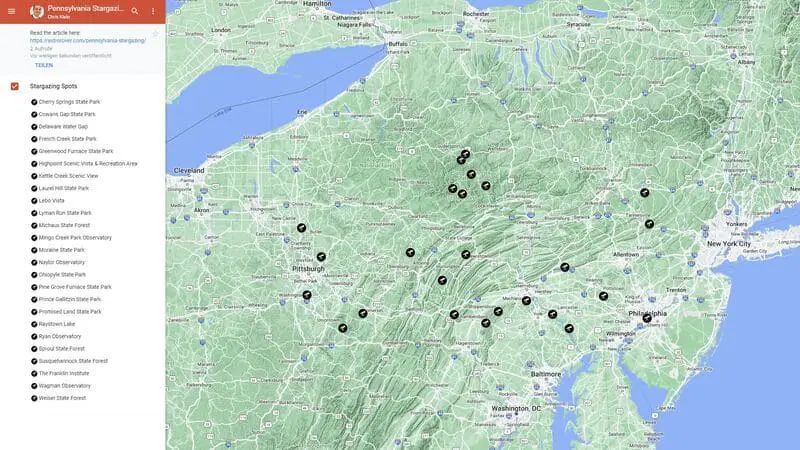
Read my dedicated article to find the best stargazing spots in Pennsylvania.
If you’re looking for the perfect spot in Pennsylvania to gaze at the stars, you’re in luck!
There are several exceptional dark sky parks and observatories that provide stunning celestial views, far away from light pollution. I’ve personally visited Cherry Springs State Park, Pennsylvania’s first Dark-Sky Park, and the unobstructed 360-degree view of the night sky is breathtaking.
Furthermore, Cowan’s Gap State Park and French Creek State Park are ideal for a stargazing adventure.
FREE STARGAZING CHECKLIST
My 5-page Stargazing Checklist will enhance your astronomical observations.
Follow this free checklist to navigate the night sky with confidence, clarity, and a sense of preparedness for a rewarding stargazing experience.

When planning your visit, be sure to:
- Check the weather forecast
- Choose a location with minimal light pollution
- Bring along helpful tools, such as star maps or stargazing apps
Rural Retreats: Remote Areas Offering the Best Celestial Views
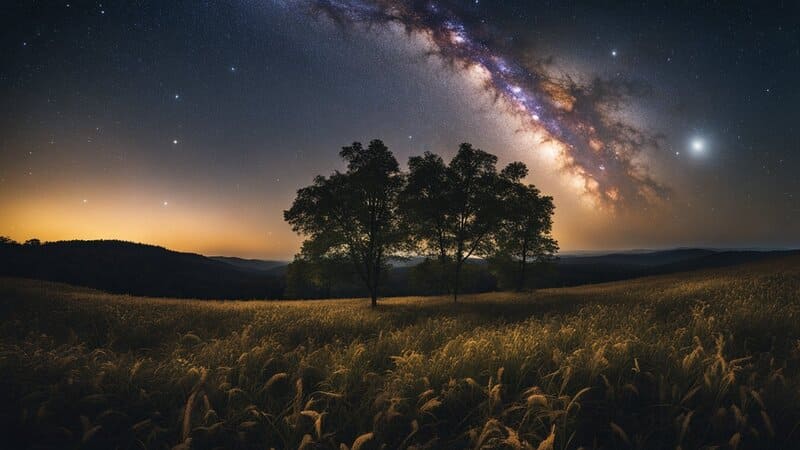
Sometimes, the best stargazing spots are those far from city lights in picturesque, rural areas. When I wanted to escape the city lights, I consulted a Bortle Light Pollution Map. It helped me find the perfect remote location with minimal light pollution.
Here are a few tips to make your stargazing experience unforgettable:
- Bring a comfortable chair or blanket for relaxed sky-watching
- Use red-colored flashlights to preserve night vision
- Be patient – give your eyes time to adjust to the darkness
By following these suggestions, you’ll discover Pennsylvania’s hidden stargazing gems and enjoy breathtaking views of the night sky.
The Quest for Dark Skies: Navigating Light Pollution in Pennsylvania
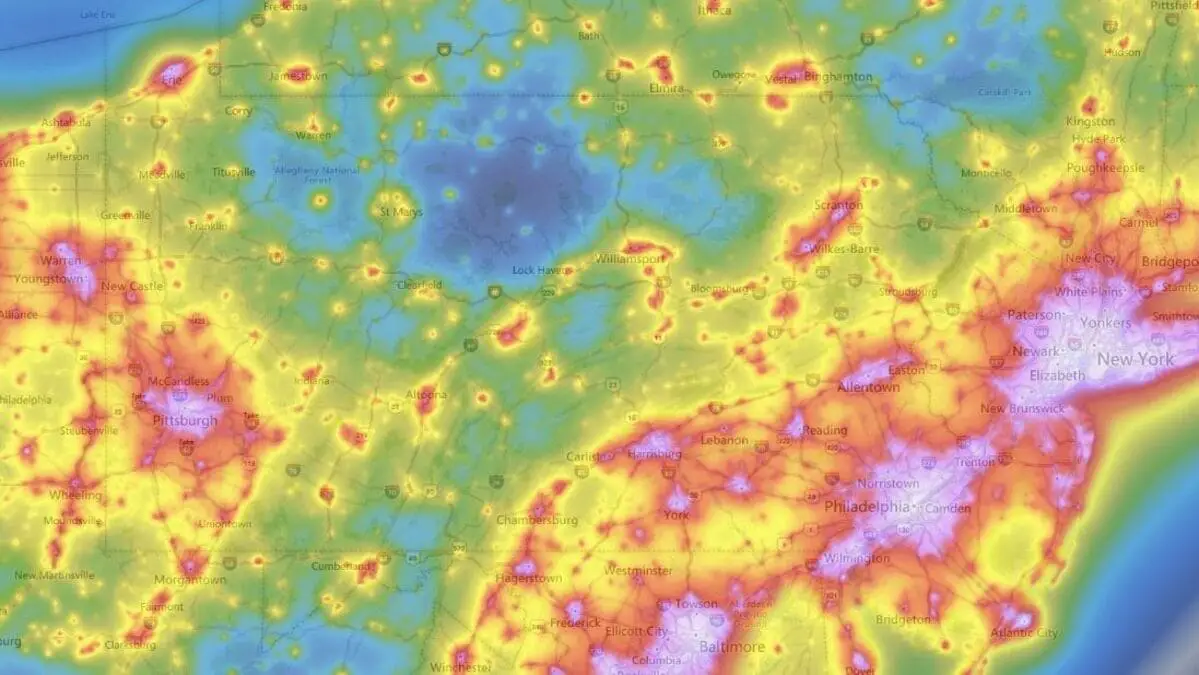
Understanding the Impacts of Light Pollution on Astronomy and Wildlife
What are the impacts of light pollution on astronomy and wildlife?
Light pollution affects both astronomy and wildlife significantly. For astronomers, excessive light makes it challenging to observe celestial objects. Wildlife, like birds and insects, can be disoriented by unnatural lighting, leading to potentially dangerous situations. Understanding these impacts is crucial for conservation and stargazing.
I’ve spent several nights in Pennsylvania stargazing. However, I’ve discovered that light pollution isn’t just a minor annoyance. It has notable effects on both astronomy and wildlife.
- Light pollution makes observing celestial objects harder. This affects both amateurs like you and professionals in studying the night sky.
- Wildlife, especially birds and insects, rely on natural light for navigation. Excessive artificial light can confuse them, leading to potential hazards.
If you’re looking to stargaze in Pennsylvania, it’s key to recognize the light pollution in various areas. Before setting out:
- I always refer to the Bortle Light Pollution Maps. They highlight sky brightness and point to the ideal spots for stargazing.
- Stay informed about the light pollution in your area. Do your best to reduce its effect when possible.
Even if you can’t influence your neighborhood’s lighting, your personal light usage matters. Being mindful can help curb light pollution.
Some tips to help curb light pollution include:
- Use lower-wattage bulbs or energy-efficient LED lights
- Turn off unnecessary lights when not needed
- Install outdoor fixtures that direct light downward to minimize light pollution
By being more aware of light pollution and its effects, you can help make a positive change for astronomy enthusiasts and Pennsylvania’s wildlife.
Organizing Stellar Stargazing Trips in Pennsylvania’s Darkest Corners

Tools and Resources for Night Sky Exploration
Pennsylvania offers a variety of excellent stargazing spots, including Cherry Springs State Park, Cowan’s Gap State Park, and French Creek State Park. To make the most of your night sky adventure, here are some tools and resources to get you started:
- Star maps and apps: I regularly use apps like SkyView or Stellarium to identify constellations and other celestial objects, and they never fail to impress.
- Telescope or binoculars: A simple pair of binoculars can enhance your view, while a telescope provides a closer look at the wonders of the night sky.
- Red flashlight: This allows you to see in the dark without ruining your night vision.
Tips for a Successful and Memorable Stargazing Experience
What tips can make your stargazing experience successful and memorable?
Preparation is vital to ensuring a successful and memorable stargazing experience. Equip yourself with essential tools like a quality telescope and sky maps. Choose a location with minimal light pollution and check the weather forecast for clear skies. These factors contribute to an enriching stargazing adventure.
To ensure your stargazing trip in Pennsylvania is unforgettable, follow these tips:
- Check the weather: I’ve learned the hard way that checking the weather for clear skies and low humidity is crucial; cloudy or foggy conditions can easily obscure the stars. Also, plan your trip around new moon phases when the sky is the darkest.
- Dress appropriately: Nights can be chilly, even in the summer. Bring warm clothing and blankets to make your stargazing experience comfortable.
- Be patient: Give your eyes time to adjust to the darkness before attempting to locate any celestial objects.
- Pack the essentials: Remember snacks, water, and insect repellent.
So go ahead, grab your telescope, gather your friends, and embark on a fantastic journey to experience the enchanting night skies of Pennsylvania.
Championing Change: Raising Awareness of Pennsylvania’s Light Pollution Issues
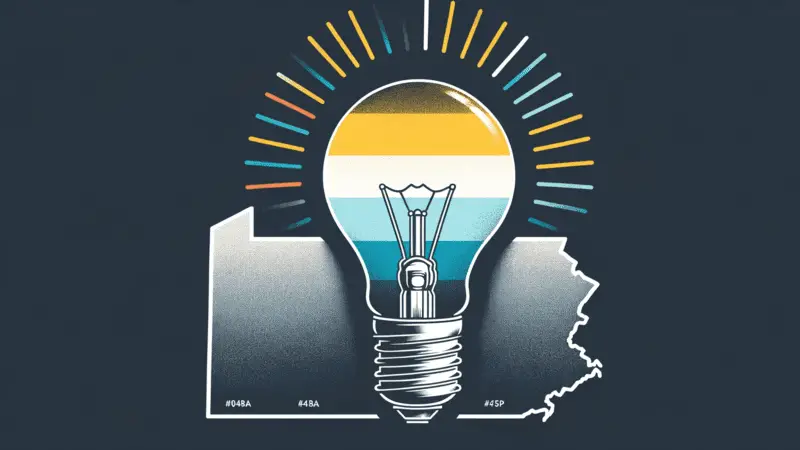
The Environmental and Human Impacts of Over-illumination
Imagine you’re stargazing on a clear night in Pennsylvania. But, you struggle to see the stars due to a problem increasing across the state – light pollution. Over-illumination can disturb wildlife, disrupt ecosystems, and affect human health. For instance, too much artificial light at night can confuse nocturnal animals and lead birds to migrate at the wrong time. Additionally, excessive lighting can cause sleep difficulties and health problems for people.
Grassroots Movements: Local Initiatives Combatting Light Pollution
Luckily, various grassroots movements are taking action. In the Pennsylvania Wilds, community members and environmental groups are addressing light pollution. They recognize the value of preserving the night sky and are proposing regulations to protect it.
Here are some steps you can take to join the fight against light pollution:
- Use outdoor lighting responsibly: Opt for shielded, energy-efficient fixtures directing light downward.
- Spread the word: Share the importance of dark skies with friends, family, and neighbors.
- Support local initiatives: Join or donate to organizations campaigning for dark sky-preserving regulations.
After stargazing in Pennsylvania, I firmly believe that together, we can make the state’s nights a bit more starry and mitigate the negative impacts of light pollution.
A Historical Perspective: Tracking the Evolution of Pennsylvania’s Night Sky
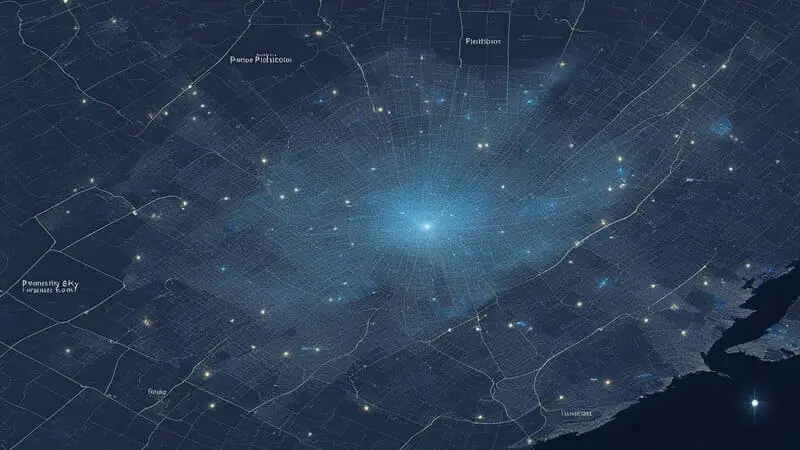
Assessing Decades of Transformation: From Pristine Skies to Urban Glow
Pennsylvania’s night sky was once clear, showcasing the cosmos brilliantly. Stars shone brightly until urban development introduced light pollution.
Now, in Pennsylvania, the once-clear stars battle the glare from cars, streetlights, and buildings. In most areas, only the brightest stars are faintly visible.
The Role of Urban Development and Infrastructure in Altering Nightscapes
Urban development in Pennsylvania has played a significant role in changing its once-pristine night skies. As cities grew and infrastructure expanded, artificial light sources increased dramatically. Streetlights, billboards, and building lights contribute to the urban glow, washing out the stars and altering our nightscapes.
Here are some examples of how urban development impacts the night sky:
- Increased light pollution levels: More lights mean a brighter night sky, making it harder to observe faint celestial objects like galaxies and nebulae.
- Sky glow: Light pollution from urban areas can scatter in the atmosphere, creating a dome of glowing light called sky glow that extends for miles around the city.
- Loss of stargazing spots: As suburban areas and roads have expanded, safe and accessible stargazing spots have become few and far between.
So next time you venture out to admire Pennsylvania’s night sky, take a moment to appreciate the transformation it has undergone.
Remember the pristine skies of yore and the twinkling cosmos they held, and try to keep your surroundings as dark as possible. That way, you can do your part to protect the remaining night sky wonders for future generations to enjoy.
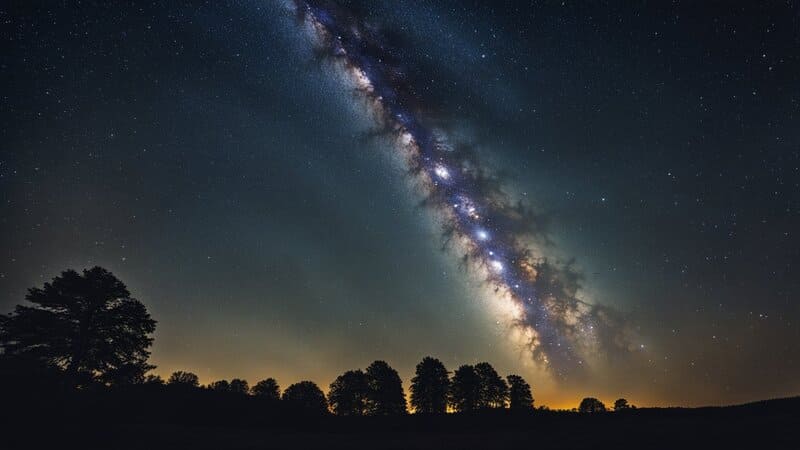
Frequently Asked Questions
How can I personally reduce light pollution in my area?
You can take steps to reduce light pollution right in your backyard. Consider replacing bright outdoor lights with lower-wattage bulbs or energy-efficient LED lights. Encourage your community to adopt smart lighting policies.
How reliable are the Bortle Light Pollution Maps for stargazing?
The Bortle Light Pollution Maps are a reliable resource for stargazers. They’re frequently updated to reflect changes in light pollution. Both amateur and professional astronomers widely use them to find optimal stargazing locations.
Can I see a significant difference in the night sky at a Dark-Sky Park like Cherry Springs?
Yes, the difference at a Dark-Sky Park like Cherry Springs is remarkable. These parks offer an almost entirely unobstructed view of the night sky, allowing you to see celestial bodies much more clearly than in light-polluted areas.
Final Words: Light Pollution Map Pennsylvania
In your stargazing journey, knowledge is as vital as the telescope you use. From understanding the significance of low light pollution areas in Pennsylvania to the impacts of light pollution on astronomy and wildlife, you’ve covered ground that not only enriches your experience but also serves a greater good. With these tips and insights, you’re not just looking up; you’re going beyond. Here’s to clear skies and discoveries.
Happy Stargazing!




